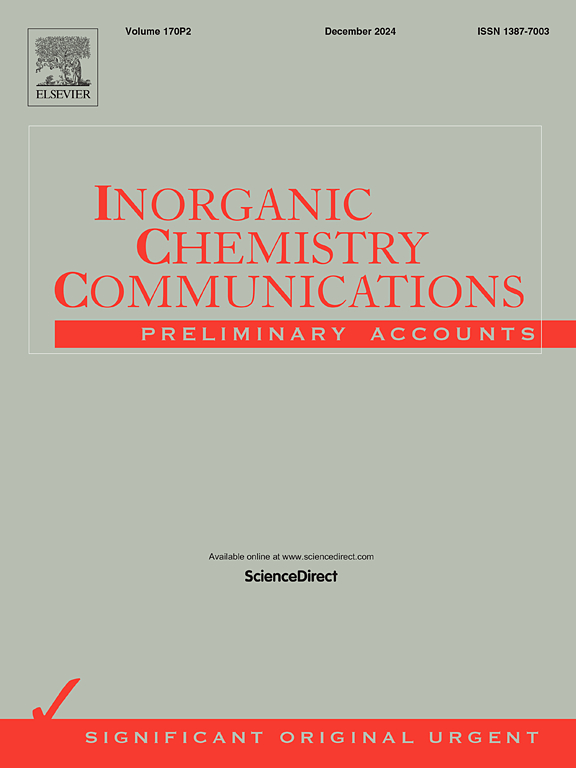掺铈催化剂在二氯甲烷氧化中的催化活性和选择性
IF 4.4
3区 化学
Q1 CHEMISTRY, INORGANIC & NUCLEAR
引用次数: 0
摘要
氯化挥发性有机化合物(CVOCs)对人类和生态环境构成重大威胁。贵金属催化剂虽然可以实现CVOCs的低温高效降解,但其成本高、易积碳、易烧结等缺点限制了其实际应用。而且,反应产生的有毒副产物很容易吸附在催化剂表面,导致活性位点中毒。在此基础上,本研究采用两步水热法制备了四种铈铬掺杂催化剂Ce1-xCrxO2-M,其中M分别代表棒(R)、立方(C)、颗粒(P)和主轴(S),系统研究了铬掺杂对CeO2结构重塑和催化性能的影响机理。结果表明,铬掺杂诱导Ce-O-Cr固溶体的形成,通过调节氧原子排列,增加了缺陷位密度,促进了氧空位的生成,显著增强了气相氧的俘获和活化。其中Ce1-xCrxO2-S表现出最佳的DCM降解性能(T50 = 179℃,T90 = 304℃),这是由于其独特形态的高比表面积,表面高密度的酸性位点促进C- cl键的解离,以及优化的氧化还原性能加速活性氧的生成和转化,协同实现了DCM的高效率和深度。三种协同作用实现了DCM的高效深部成矿作用。工艺优化表明,500℃焙烧能有效保持活性结构。此外,Ce1-xCrxO2-S具有优异的热稳定性和耐水性。本文章由计算机程序翻译,如有差异,请以英文原文为准。

Catalytic activity and selectivity of Cerium-Doped catalysts in dichloromethane oxidation
Chlorinated volatile organic compounds (CVOCs) pose a significant threat to human beings and the ecological environment. Although noble metal catalysts can realize the low-temperature and efficient degradation of CVOCs, their high cost and easy to accumulate carbon and sintering limit the practical application. What’s more, the toxic by-products generated from the reaction are easy to be adsorbed on the catalyst surface, leading to the poisoning of the active sites. Based on this, four cerium-chromium doped catalysts, Ce1-xCrxO2-M, where M stands for rod (R), cube (C), particle (P), and spindle (S), were prepared by a two-step hydrothermal method in the present study to systematically investigate the mechanism of chromium doping on the structural remodeling and catalytic performance of CeO2. It is shown that chromium doping induces the formation of Ce-O-Cr solid solution, which increases the defect site density and promotes the generation of oxygen vacancies by regulating the oxygen atom arrangement, and significantly enhances the trapping and activation of gas-phase oxygen. Among them, Ce1-xCrxO2-S showed the best DCM degradation performance (T50 = 179 °C, T90 = 304 °C), which was attributed to the high specific surface area of the unique morphology, the high density of acidic sites on the surface to promote the dissociation of the C-Cl bond, and the optimized redox properties to accelerate the generation and conversion of reactive oxygen species, which synergistically achieved the high efficiency and depth of the DCM. The three synergies achieved the efficient deep mineralization of DCM. The process optimization shows that 500 ℃ roasting can effectively maintain the active structure. In addition, Ce1-xCrxO2-S has excellent thermal stability and water resistance.
求助全文
通过发布文献求助,成功后即可免费获取论文全文。
去求助
来源期刊

Inorganic Chemistry Communications
化学-无机化学与核化学
CiteScore
5.50
自引率
7.90%
发文量
1013
审稿时长
53 days
期刊介绍:
Launched in January 1998, Inorganic Chemistry Communications is an international journal dedicated to the rapid publication of short communications in the major areas of inorganic, organometallic and supramolecular chemistry. Topics include synthetic and reaction chemistry, kinetics and mechanisms of reactions, bioinorganic chemistry, photochemistry and the use of metal and organometallic compounds in stoichiometric and catalytic synthesis or organic compounds.
 求助内容:
求助内容: 应助结果提醒方式:
应助结果提醒方式:


